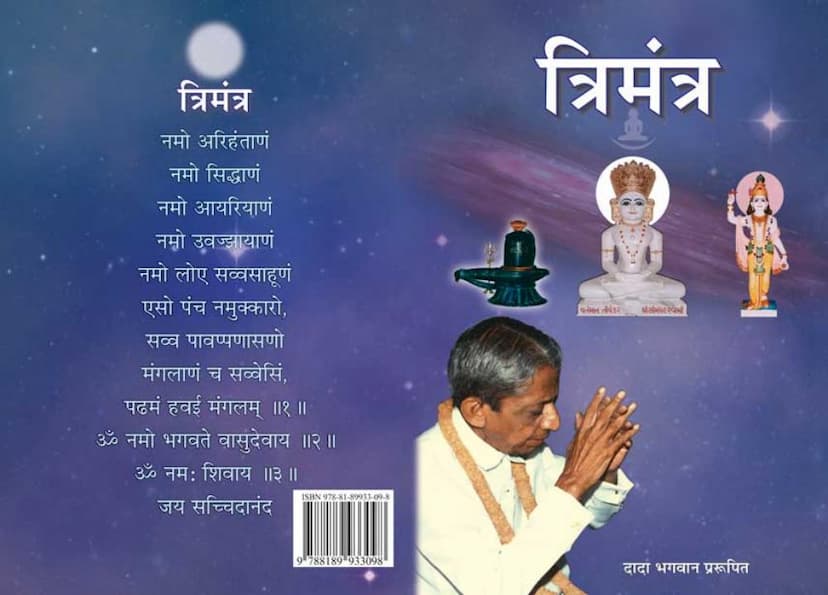Trimantra
Added to library: September 2, 2025

Summary
This document is a summary of the Jain text "Trimantra" by Dada Bhagwan, published by Mahavideh Foundation. The book focuses on explaining the significance and meaning of the Trimantra, a combination of three key mantras from different religious traditions: the Jain Navkar Mantra, the Vasudeva mantra, and the Shiva mantra.
Here's a breakdown of the key themes and content:
1. Dada Bhagwan and the Trimantra:
- Dada Bhagwan: The book introduces Dada Bhagwan (Shri Ambalal Muljibhai Patel) as a Self-realized being who naturally manifested in 1958. He possessed the ability to impart Self-knowledge in a few hours, following an "akram" (shortcut) path. He emphasized that the "Dada Bhagwan" within is the pure Soul, the Lord of the fourteen realms, and is present in everyone. He lived by the principle "Religion should be in business, not business in religion."
- The Trimantra's Purpose: Dada Bhagwan explained that the Trimantra is a unified, impartial mantra that transcends religious boundaries. Its purpose is to remove obstacles in life, foster impartiality, and lead towards liberation (moksha). It is presented as a means to gain peace and overcome worldly challenges.
2. Breakdown of the Trimantra and its Meaning:
The book delves into the meaning of each mantra within the Trimantra, offering profound spiritual explanations:
-
The Jain Navkar Mantra (Page 8-17):
- "Namo Arihantanam": This is explained as salutation to the Arihants, those who have conquered inner enemies like anger, pride, deceit, and greed. It clarifies that Arihants are currently living enlightened beings (like Simandhar Swami) and not the Siddha (liberated) souls. The text highlights the importance of acknowledging the present Tirthankaras as Arihants for the mantra's efficacy.
- "Namo Siddhanam": This salutes the Siddhas, souls who have attained liberation from the cycle of birth and death and reside in the Siddha state. The twenty-four Tirthankaras are included here as they have attained Siddhahood.
- "Namo Ayariyanam": This honors the Acharyas, spiritual masters who follow the teachings of the Arihants and guide others. True Acharyas are those who have attained Self-knowledge and are unwavering in their conduct. The text distinguishes between true and false Acharyas, emphasizing the importance of vision and conduct.
- "Namo Upajjhayanam": This salutes the Upadhyayas, those who have attained Self-knowledge and are dedicated to studying and teaching scriptures. They have attained some level of conduct but are not fully perfected in it, unlike Acharyas.
- "Namo Loye Savvasadhunam": This honors all Sadhus (ascetics) in the world who are striving for or have attained the state of the Self (Atmadasha). True Sadhus are those who are free from worldly attachments and possess pure spiritual endeavors.
-
"Om Namo Bhagavate Vasudevaya" (Page 19-21):
- This mantra is dedicated to Vasudeva, who evolves from human (Nar) to divine (Narayana). The book uses the example of Krishna as a Vasudeva. It explains that Vasudevas and Prati-Vasudevas (antagonists) are significant figures in spiritual history, and the text advocates for respecting them, even figures like Ravana, who were highly knowledgeable. The concept of "Shalaka Purush" (illustrious men) is introduced, encompassing Tirthankaras, Chakravartis, Vasudevas, Prati-Vasudevas, and Baldevs.
-
"Om Namah Shivaya" (Page 21-23):
- This mantra is explained as a salutation to Shiva, which is not a person but a state of being – the embodiment of welfare and auspiciousness. It encourages embodying the qualities of Shiva by enduring worldly hardships (like poison) with equanimity. The text clarifies that "Shivoham" (I am Shiva) can only be truly spoken by those who have experienced that state, not merely by repetition.
-
"Jai Sachchidanand" (Page 23, 28):
- This is a concluding chant that encompasses all the diverse spiritual paths and divine figures within Hinduism and beyond. It signifies the ultimate state of pure bliss and the realization of the Self.
3. Key Teachings and Concepts:
- Impartiality and Unity: The central theme is that God and the ultimate truth are impartial. The Trimantra's strength lies in its unification of mantras from different faiths, promoting harmony and transcending sectarianism.
- Practical Application: The book emphasizes that chanting the Trimantra can help alleviate worldly difficulties and provide peace. It's recommended to chant it regularly, even loudly in solitude, to quiet the mind and intellect.
- Understanding vs. Repetition: Simply chanting the mantras is not enough; understanding their meaning and intent is crucial for deriving true benefit. The text stresses that true chanting engages all senses.
- Akram Marg: The teachings are presented within the context of Dada Bhagwan's "akram" path, emphasizing a direct, spiritual realization rather than a gradual, step-by-step approach.
- The Role of the Gnani: The book reiterates that true understanding of these spiritual concepts comes from a Gnani (Self-realized being) like Dada Bhagwan.
- The Goal is Moksha: While the Trimantra helps with worldly issues, its ultimate aim is to guide individuals towards Self-realization and liberation.
In essence, the book "Trimantra" by Dada Bhagwan presents a profound perspective on spiritual unity, offering a practical guide to navigating worldly challenges and aspiring towards the ultimate goal of liberation through the combined power and understanding of universal mantras.